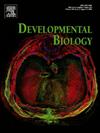Geldanamycin inhibits in vivo and in vitro chick skeletal myogenesis
IF 2.5
3区 生物学
Q2 DEVELOPMENTAL BIOLOGY
引用次数: 0
Abstract
During skeletal muscle development catabolic and anabolic events are finely orchestrated by several heat shock proteins (HSP). HSP90 are molecular chaperones which play an essential role in maintaining cellular homeostasis. Although HSP90 proteins have been widely studied in cancer cells, their role during skeletal myogenesis has not been completely explored. Here, we studied the role of HSP90 during in vivo and in vitro development of embryonic chick muscle fibers. First, we analyzed the effects of the inhibition of HSP90 by geldanamycin in skeletal muscle tissues in chick embryos in vivo. Geldanamycin was applied to E2 chicken embryos in vivo, and six days later, we observed a reduction in desmin-positive cells in the pectoral muscle. To deeper analyze the role of HSP90 during myogenesis, we used primary cultures of chick pectoral muscle cells which contain myoblasts, myotubes and muscle fibroblasts. We observed an intense accumulation of HSP90 in the perinuclear region of myoblasts and myotubes, but not in muscle fibroblasts. In myotubes, besides the perinuclear localization, HSP90 was found colocalized with myofibers, whereas in myoblasts and fibroblasts HSP90 was found as a mesh of small filaments and aggregates in the cytoplasm. Fibroblasts showed lower HSP90 expression, as compared to myoblasts and myotubes. Inhibition of HSP90 by geldanamycin reduced the size of myotubes, the number of nuclei within myotubes and myoblast fusion index, indicating an inhibition of myogenesis. Furthermore, geldanamycin induces both an increase in the number of fibroblasts and the formation of giant binucleated fibroblasts, suggesting that HSP90 inhibition induces cytokinesis block in muscle fibroblasts by interfering in actin and myosin activity. The collection of our results shows that the inhibition of HSP90 hinders in vivo and in vitro chick skeletal myogenesis, and differentially affects muscle and non-muscle cells, underlying different functions of HSP90 in different cell types.

求助全文
约1分钟内获得全文
求助全文
来源期刊

Developmental biology
生物-发育生物学
CiteScore
5.30
自引率
3.70%
发文量
182
审稿时长
1.5 months
期刊介绍:
Developmental Biology (DB) publishes original research on mechanisms of development, differentiation, and growth in animals and plants at the molecular, cellular, genetic and evolutionary levels. Areas of particular emphasis include transcriptional control mechanisms, embryonic patterning, cell-cell interactions, growth factors and signal transduction, and regulatory hierarchies in developing plants and animals.
 求助内容:
求助内容: 应助结果提醒方式:
应助结果提醒方式:


